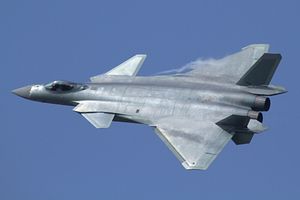The People’s Liberation Army Air Force’s (PLAAF) purported first fifth-generation stealth fighter aircraft, the Chengdu Aerospace Corporation (CAC) J-20A multirole fighter, conducted its first over-the-sea combat exercise, the PLAAF announced this week.
“The J-20 has conducted a combat training mission in sea areas for the first time, and this has further strengthened the comprehensive combat capability of the PLA Air Force,” PLAAF spokesperson Shen Jinke said on May 9, without specifying the date or location of the combat training.
“It will help the air force better fulfill its sacred duty of safeguarding China’s sovereignty, security and territorial integrity,” Shen added.
The J-20A is China’s most advanced domestically produced fighter jet to date. The aircraft is a twin-engine, single-seat fifth-generation (designated fourth-generation in the PLAAF) air superiority fighter, designed and built by CAC. The J-20A, armed with beyond visual range air-to-air missiles such as the PL-12, is specifically designed for long-range fighter missions.
However, as I explained in March, there is considerable doubt about the J-20’s stealth capabilities:
Among other things, it lacks an indigenously developed and designed next-generation high performance turbofan jet engine and continues to rely on older Russian-made models lacking (…) thrust vectoring.
Additionally, as I reported in October 2017:
The domestically developed WS-15 turbofan engine, a thrust engine under development since the 1990s, has not entered serial production. It is assumed that the first patch of J-20s is equipped with an unknown variant of the Saturn AL-31, an older Russian-made jet engine. According to some sources, the J-20 is still purportedly incapable of super cruising — sustained supersonic flight [without using afterburners].
Furthermore, the J-20A’s avionics reportedly also do not meet Western fifth-generation standards and the aircraft’s stealth coating — radiation absorbent material intended to reduce the reflection of electromagnetic waves — purportedly also has shortcomings.
Nonetheless, China’s new fighter jet has continued to make headlines in recent months. In January, J-20As took part in an air combat exercise at an undisclosed air base in China. While it was not the first aerial combat drill for the J-20 it was the first time that the PLAAF publicly confirmed the participation of the fighter aircraft in such an exercise.
The PLAAF rushed the J-20A into service in 2017. The aircraft also entered limited serial production before officially reaching full operational capability. Whether this is was a wise long-term aircraft procurement strategy remains to be seen. CAC is expected to produce three J-20As per month. The PLAAF intends to operate more than 100 J-20s by the end of the 2020s. It unclear how many J-20As are currently in service with the PLAAF; estimates vary from six to 13 (eight J-20A prototypes and five low rate initial production fighter jets).
































